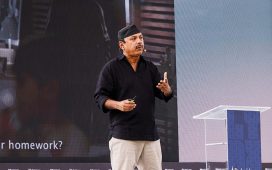Do we as an industry wish to fool the system and gain fake glory, or do we wish to solve the genuine marketing challenges that all of our clients face, asks Leo Burnett’s Kamal Dimachkie
The RTA deserves credit, much credit for the job it is doing in elevating road standards and driving conditions all over Dubai. Credit is due for the infrastructure that is becoming genuinely world class, and for the organisation and speed of responsiveness to the automotive and commuting demands of a fast-growing city.
It’s also due for the use of the latest speed monitoring systems and surveillance to ensure better safety and oversight, and, last but by no means least, for the continuous improvements and upgrades required so that the traffic needs of the city do not lag behind its roads.
Clearly, the RTA merits – seeing as the Dubai Lynx is still fresh in our minds – a grand prix in what should have been a newly-created category this year. Sadly, there was no such category, and the RTA won nothing.
Praiseworthy as it is, we are not here to award the Roads & Traffic Authority. More interesting are the hundreds of thousands of human stories that unfold every day on the roads. With all the infrastructure, technology, human resource and capital deployed to enable, facilitate and drive progress, it all simply boils down to those who use the roads; to the drivers… to people. It boils down to their skill, capability, to the roadworthiness of their vehicles, attitude, manners and emotional states. They determine the experience for the rest of us.
The RTA, qualified and equipped as it may be, is not immune to human ability to inflict harm, intended or unintended, and cannot turn the clock back to undo it.
How similar all that is to what we see unfold at the Dubai Lynx every year. There is no doubt that the Lynx has helped elevate the creative standards in our region. The Lynx, like the RTA, has invested in infrastructure, provided clarity on rules of engagement, created an environment and ecosystem that foster, encourage and celebrate creativity. It has also introduced checks and balances to ensure that it is real work that gets acknowledged, that wins and that is publicly acclaimed. And though its system filters a considerable amount of work that attempts to outsmart the rules, it is neither infallible nor immune to people’s determination to outsmart it.
Creative work, that is not genuine but is sufficiently compliant with the rules set by the Lynx, and that is backed by possible client collusion, renders Lynx defenceless. In the same way that a determined driver can escape the detection of the RTA, such work can escape the scrutiny of the Lynx.
Today we have reached a milestone that we should celebrate and cherish. During this year’s Lynx we saw quite a few pieces of work that have been rightly and deservedly recognised. Work such as Ogilvy Tunisia’s ‘The 12th Man’ and Dubai’s ‘The Autocomplete Truth’, the work on du Tuesday, and quite a few other pieces are all wonder-ful examples that combined the power of human insight, context and, in the case of Tunisia’s example, beautifully placed technology at the service of creativity. In so doing, they treated wide audiences to the magic communication can produce.
Yet as we celebrate such success and standards we should not forget the journey, the body and the people that got us here. A collaborative effort made the Lynx a reality today and for the past several years. This effort is to thank for the fact that we stand to reap the benefits of a richer output of material that have earned the region a solid place on the creative map.
But we also stand at a crossroads and we need to make a decision, both as an industry and as communication pract-itioners. It is no secret that within the rich body of creative work that we celebrated, there were a number of pieces that were simply wonderful in idea and in craft – a truly remarkable demonstration of what talent from this region is capable of – yet that were the product of much proactivity and little genuineness. So the question is, do we wish to fool the system and gain fake glory, or do we wish to solve the genuine marketing challenges that our clients face, and stand out with the integrity of clean wins? No matter how thorough and capable the Lynx and its juries are, they remain no match to the creativity of people determined to outsmart the system.
The milestone we have reached, and the crossroads at which we stand, remind us that unless we self-regulate, and exercise discipline and self-censorship, and unless we focus our efforts as a creative industry on genuine client and brand work that requires real solutions to marketing and communication challenges, the road to the Lynx will be littered with accidents, much disappointment and fake wins. The Lynx this year has given us hope because of the wealth of genuine wins, and it has given us a warning of the dangers along the way. May we all heed its cautionary tale.
Kamal Dimachkie is executive regional managing director at Leo Burnett










Rip-Off? UN Women ‘The Autocomplete Truth’
Rip-Off? Coke Social Media Guard
http://adbasha.blogspot.ae